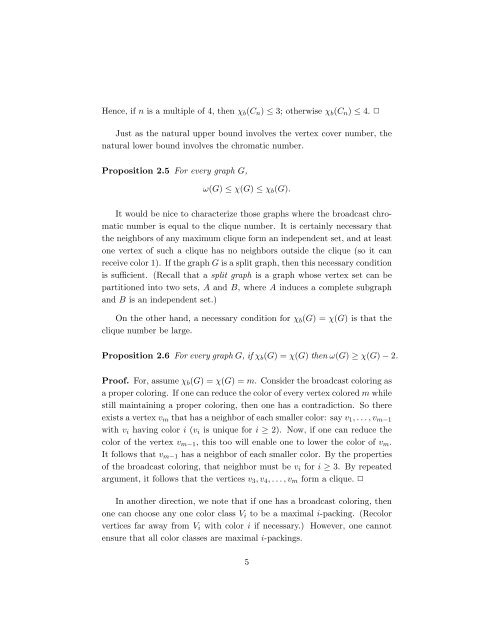Broadcast Chromatic Numbers of Graphs 1 ... - ResearchGate
Broadcast Chromatic Numbers of Graphs 1 ... - ResearchGate
Broadcast Chromatic Numbers of Graphs 1 ... - ResearchGate
You also want an ePaper? Increase the reach of your titles
YUMPU automatically turns print PDFs into web optimized ePapers that Google loves.
Hence, if n is a multiple <strong>of</strong> 4, then χ b (C n ) ≤ 3; otherwise χ b (C n ) ≤ 4. ✷Just as the natural upper bound involves the vertex cover number, thenatural lower bound involves the chromatic number.Proposition 2.5 For every graph G,ω(G) ≤ χ(G) ≤ χ b (G).It would be nice to characterize those graphs where the broadcast chromaticnumber is equal to the clique number. It is certainly necessary thatthe neighbors <strong>of</strong> any maximum clique form an independent set, and at leastone vertex <strong>of</strong> such a clique has no neighbors outside the clique (so it canreceive color 1). If the graph G is a split graph, then this necessary conditionis sufficient. (Recall that a split graph is a graph whose vertex set can bepartitioned into two sets, A and B, where A induces a complete subgraphand B is an independent set.)On the other hand, a necessary condition for χ b (G) = χ(G) is that theclique number be large.Proposition 2.6 For every graph G, if χ b (G) = χ(G) then ω(G) ≥ χ(G) − 2.Pro<strong>of</strong>. For, assume χ b (G) = χ(G) = m. Consider the broadcast coloring asa proper coloring. If one can reduce the color <strong>of</strong> every vertex colored m whilestill maintaining a proper coloring, then one has a contradiction. So thereexists a vertex v m that has a neighbor <strong>of</strong> each smaller color: say v 1 , . . .,v m−1with v i having color i (v i is unique for i ≥ 2). Now, if one can reduce thecolor <strong>of</strong> the vertex v m−1 , this too will enable one to lower the color <strong>of</strong> v m .It follows that v m−1 has a neighbor <strong>of</strong> each smaller color. By the properties<strong>of</strong> the broadcast coloring, that neighbor must be v i for i ≥ 3. By repeatedargument, it follows that the vertices v 3 , v 4 , . . .,v m form a clique. ✷In another direction, we note that if one has a broadcast coloring, thenone can choose any one color class V i to be a maximal i-packing. (Recolorvertices far away from V i with color i if necessary.) However, one cannotensure that all color classes are maximal i-packings.5
















